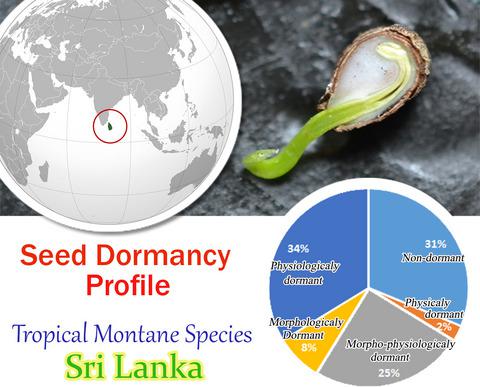当前位置:
X-MOL 学术
›
Plant Biol.
›
论文详情
Our official English website, www.x-mol.net, welcomes your
feedback! (Note: you will need to create a separate account there.)
Seed dormancy of 80 tropical montane forest species in Sri Lanka, the first dormancy profile for a tropical montane forest community
Plant Biology ( IF 4.2 ) Pub Date : 2020-10-22 , DOI: 10.1111/plb.13203 Y. S. Athugala 1, 2 , K. M. G. Gehan Jayasuriya 1, 2 , A. M. T. A. Gunaratne 1, 2 , C. C. Baskin 3, 4
中文翻译:

斯里兰卡80种热带山地森林物种的种子休眠,这是热带山地森林社区的第一个休眠模式
更新日期:2020-10-22
Plant Biology ( IF 4.2 ) Pub Date : 2020-10-22 , DOI: 10.1111/plb.13203 Y. S. Athugala 1, 2 , K. M. G. Gehan Jayasuriya 1, 2 , A. M. T. A. Gunaratne 1, 2 , C. C. Baskin 3, 4
Affiliation

|
- Community‐level seed dormancy studies are important in understanding the dynamics of plant communities and adaptations of species to their habitat. Our aim was to develop a seed dormancy profile for tropical montane forests of Sri Lanka, which are a global biodiversity hotspot, and compare it to the profile made using a world database for this vegetation type.
- Germination, imbibition and embryo length : seed length ratio of seeds were determined for 80 Sri Lankan montane forest species.
- Seeds of 31 species were fast‐germinating with a median length of germination (MLG) <30 days and the remaining 49 were slow‐germinating with MLG >30 days. Embryos of six fast‐germinating species grew prior to radicle emergence, indicating morphological dormancy (MD). The other 25 fast‐germinating species had non‐dormant (ND) seeds. Manually scarified seeds of two species imbibed significantly more water than non‐scarified seeds, revealing physical dormancy (PY). Embryos of 20 slow‐germinating species grew prior to radicle emergence, confirming morpho‐physiological dormancy (MPD). The remaining slow‐germinating species had a fully developed embryo and thus physiological dormancy (PD). The percentage of species with ND seeds and with MD, MDP, PD and PY was 31, 7.5, 25, 34 and 2.5, respectively.
- Species with dormant seeds (70%) dominate the Sri Lankan montane forest community similar to the world database, with 85% dormant seeds. Seed dormancy may be an adaptation that prevents seeds from germinating during the Sri Lankan dry season from December to March when conditions are unfavourable for seedling growth due to low water availability.
中文翻译:

斯里兰卡80种热带山地森林物种的种子休眠,这是热带山地森林社区的第一个休眠模式
- 社区一级的种子休眠研究对于了解植物群落的动态以及物种对其生境的适应性至关重要。我们的目标是为斯里兰卡的热带山地森林开发一个种子休眠概况,该地区是全球生物多样性热点,并将其与使用该植被类型的世界数据库得出的概况进行比较。
- 确定了80种斯里兰卡山地森林物种的种子的发芽,吸水和胚长:种子的长径比。
- 31种种子发芽快,中位发芽长度(MLG)<30天,其余49种发芽慢,MLG> 30天。六个快速发芽物种的胚在胚根出现之前生长,表明形态休眠(MD)。其他25个快速发芽物种具有非休眠(ND)种子。两种非人工种子的人工擦干种子吸收的水比非硬纸板的多得多,显示出物理休眠状态(PY)。在胚根出现之前先生长了20个缓慢发芽物种的胚,这证明了形态生理休眠(MPD)。其余缓慢发芽的物种具有完全发育的胚胎,因此具有生理休眠性(PD)。带有ND种子和带有MD,MDP,PD和PY的物种百分比分别为31、7.5、25、34和2.5。
- 与世界数据库相似,具有休眠种子的物种(占70%)主导着斯里兰卡的山地森林群落,其中休眠种子的占85%。种子休眠可能是一种适应措施,可防止种子在12月至3月的斯里兰卡干旱季节发芽,此时由于水分供应不足,不利于幼苗生长。











































 京公网安备 11010802027423号
京公网安备 11010802027423号